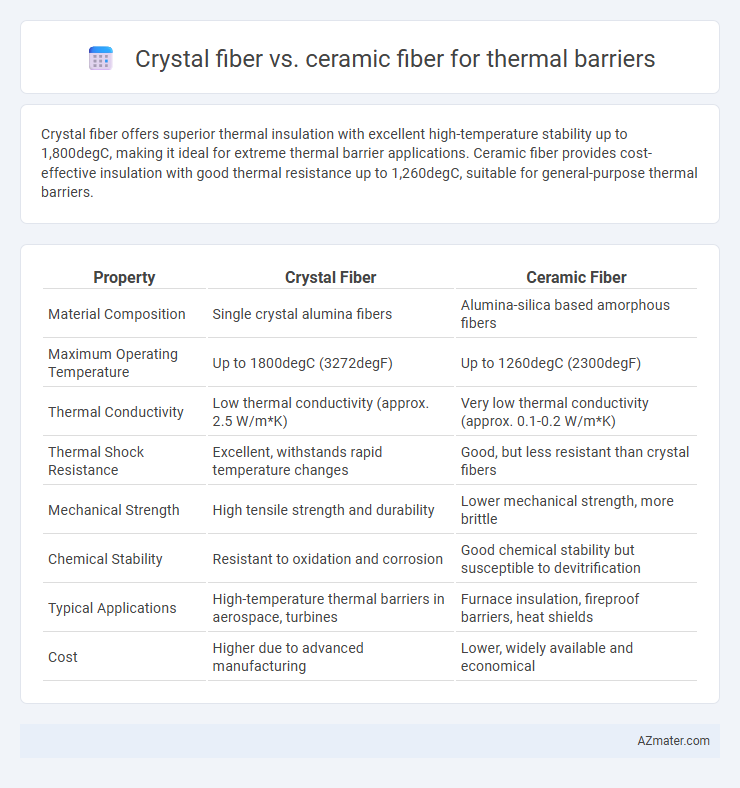Crystal fiber offers superior thermal insulation with excellent high-temperature stability up to 1,800degC, making it ideal for extreme thermal barrier applications. Ceramic fiber provides cost-effective insulation with good thermal resistance up to 1,260degC, suitable for general-purpose thermal barriers.
Table of Comparison
| Property | Crystal Fiber | Ceramic Fiber |
|---|---|---|
| Material Composition | Single crystal alumina fibers | Alumina-silica based amorphous fibers |
| Maximum Operating Temperature | Up to 1800degC (3272degF) | Up to 1260degC (2300degF) |
| Thermal Conductivity | Low thermal conductivity (approx. 2.5 W/m*K) | Very low thermal conductivity (approx. 0.1-0.2 W/m*K) |
| Thermal Shock Resistance | Excellent, withstands rapid temperature changes | Good, but less resistant than crystal fibers |
| Mechanical Strength | High tensile strength and durability | Lower mechanical strength, more brittle |
| Chemical Stability | Resistant to oxidation and corrosion | Good chemical stability but susceptible to devitrification |
| Typical Applications | High-temperature thermal barriers in aerospace, turbines | Furnace insulation, fireproof barriers, heat shields |
| Cost | Higher due to advanced manufacturing | Lower, widely available and economical |
Introduction to Thermal Barrier Materials
Crystal fiber and ceramic fiber are both advanced thermal barrier materials used to protect components from extreme heat, with crystal fibers offering superior high-temperature resistance above 1500degC due to their alumina-silica composition. Ceramic fibers, often composed of alumina, silica, or a combination thereof, provide excellent insulation properties up to temperatures around 1260degC and are widely used for furnace linings and fireproofing. The choice between crystal fiber and ceramic fiber depends on specific application temperature requirements, mechanical strength, and thermal stability needed for effective thermal barrier protection.
Overview of Crystal Fiber Technology
Crystal fiber technology utilizes high-purity alumina-silica compositions, creating a thermal barrier with exceptional heat resistance and low thermal conductivity, ideal for industrial insulation. These fibers exhibit superior stability at temperatures exceeding 1200degC, maintaining structural integrity and insulating performance under extreme thermal stress. Compared to ceramic fibers, crystal fibers offer enhanced durability and resistance to chemical corrosion, making them suitable for advanced thermal management applications.
Overview of Ceramic Fiber Technology
Ceramic fiber technology utilizes alumina-silicate fibers known for their low thermal conductivity and high heat resistance, making them ideal for thermal barrier applications. These fibers provide excellent insulation, durability, and chemical stability at temperatures exceeding 1,200degC, outperforming many alternative materials like crystal fibers in high-temperature environments. Ceramic fibers also offer superior flexibility and resistance to thermal shock, enhancing their effectiveness in industrial insulation and refractory applications.
Thermal Insulation Performance Comparison
Crystal fiber offers superior thermal insulation performance compared to ceramic fiber, with a lower thermal conductivity typically around 0.03-0.05 W/m*K, enabling more efficient heat resistance in high-temperature applications. Ceramic fiber, while also effective, generally exhibits higher thermal conductivity values of approximately 0.06-0.10 W/m*K, resulting in slightly reduced insulation efficiency under extreme thermal conditions. The microstructure of crystal fiber provides enhanced stability and lower heat transfer rates, making it preferable for demanding thermal barrier uses where maximum insulation is critical.
Heat Resistance and Durability
Crystal fiber offers superior heat resistance, maintaining structural integrity at temperatures exceeding 1400degC, making it ideal for high-temperature thermal barrier applications. Ceramic fiber, while effective up to around 1200degC, typically exhibits lower durability under extreme thermal cycling and mechanical stress. The enhanced durability of crystal fiber ensures longer service life and better performance in harsh, high-temperature environments compared to traditional ceramic fiber insulation.
Mechanical Strength and Flexibility
Crystal fiber offers superior mechanical strength with higher tensile and compressive resistance compared to ceramic fiber, making it ideal for applications requiring durable thermal barriers under mechanical stress. Ceramic fiber exhibits greater flexibility and lower density, allowing it to conform to complex shapes and absorb thermal expansion without cracking. The choice between crystal and ceramic fiber depends on balancing the need for mechanical robustness against the requirement for flexibility in high-temperature insulation solutions.
Chemical Stability and Corrosion Resistance
Crystal fiber demonstrates superior chemical stability and corrosion resistance compared to ceramic fiber, making it ideal for harsh thermal barrier applications exposed to aggressive chemicals. Its aluminosilicate structure resists degradation from acidic or alkaline environments, maintaining integrity at elevated temperatures. In contrast, ceramic fiber is more prone to chemical attacks, especially from alkalis, which can reduce its lifespan and thermal performance under corrosive conditions.
Environmental Impact and Sustainability
Crystal fiber thermal barriers demonstrate superior environmental sustainability due to their inorganic composition, which reduces hazardous emissions and facilitates recycling compared to ceramic fibers. Ceramic fibers typically involve high energy consumption during production and release respirable crystalline silica, posing environmental and health risks. The durability and lower thermal conductivity of crystal fibers contribute to enhanced energy efficiency and reduced greenhouse gas emissions in long-term applications.
Cost-Effectiveness and Availability
Crystal fiber offers superior thermal insulation with higher resistance to temperature extremes, but its production costs are significantly higher, making it less cost-effective for large-scale applications. Ceramic fiber provides a more affordable alternative with good thermal barrier properties and broad availability in the market, which supports its widespread use in industrial insulation. Availability of ceramic fiber is enhanced by established manufacturing processes, whereas crystal fiber remains limited to specialized suppliers, impacting lead times and overall project expenses.
Applications and Industry Suitability
Crystal fiber offers superior thermal insulation and chemical resistance, making it ideal for high-temperature applications in aerospace, metal processing, and furnace linings. Ceramic fiber excels in thermal barrier performance with excellent resistance to thermal shock and corrosion, widely used in petrochemical industries, power plants, and automotive exhaust systems. Both fibers provide critical insulation solutions, with crystal fibers favored for extreme environments and ceramic fibers preferred for versatile industrial thermal management.

Infographic: Crystal fiber vs Ceramic fiber for Thermal barrier
 azmater.com
azmater.com